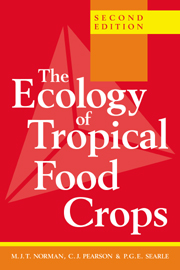17 - Yams (Dioscorea species)
Published online by Cambridge University Press: 05 June 2012
Summary
Taxonomy
The genus Dioscorea includes some 600 species, of which 50–60 are cultivated or gathered for food or pharmaceutical purposes. However, there are only about 12 species of economic significance as food plants (Coursey, 1976a). Of these, D. rotundata, grown in Africa, and D. alata, grown largely in Asia, are by far the most important, together making up about 90% of world production of food yams (Alexander & Coursey, 1969). In this chapter attention is largely confined to these two species.
D. alata, the Greater Yam, is an Asian species; D. rotundata, the White Guinea Yam, is African. Both African and Asian species have x = 10 chromosomes; American species, e.g., D. trifida, have x = 9. There is a high degree of polyploidy in the genus: 2n= 3x up to 16x. Polyploidy also occurs within species, particularly those from the Old World: D. alata is found with 2n = 30 up to 80, though D. rotundata has 2n = 40 only (Coursey, 1976a).
Origin, evolution and dispersal
The family Dioscoreaceae is probably one of the oldest groups of angiosperms, and appears to have arisen in southeast Asia (Burkill, 1960). The formation of the Atlantic Ocean at the end of the Cretaceous period separated Old and New World species, which subsequently followed a divergent evolutionary path. Desiccation of the Middle East in the Miocene period separated African and Asian species, but their later evolutionary divergence was slight (Coursey, 1976a).
- Type
- Chapter
- Information
- The Ecology of Tropical Food Crops , pp. 305 - 318Publisher: Cambridge University PressPrint publication year: 1995
- 2
- Cited by



